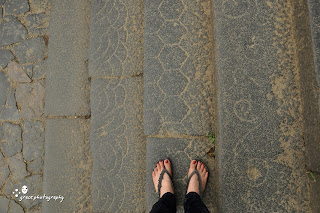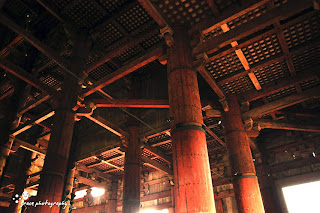Nara, another Must visit place in Japan!!! From Kyoto it's just 45 minutes away by JR train and cost 690yen/ pax for 1 way. We did a day trip to Nara from Kyoto and it was really a nice escape. Though we only had 1 day in Nara but it was enough for us to have a good impression of Nara!!
the streets has less traffic and less crowds compare to Kyoto
but one thing they don't seem to lack is temples and shrines :D
Sarusawa-ike pond
and just beside the pond there is a Information center
Warning!!! they got really bad-ass deers in Nara
steps leading up to Kofukuji Temple
passed by also a 3 storey pagoda. Almost all of the shrines has a gong, where one can bang on it to let the god knows that you are here in his temple or shrines and make a wish. Well that was what i was told to do...hehe
another neighbour we came across is the Nan en-do
Kofukuji Temple is a Buddhist temple and one of the 8 Historic Monument of Ancient Nara. The temple was establish in 710
to enter the Tokon-do Hall (Eastern Golden Hall) cost about 300yen but we bought the combined ticket 800yen that includes the Tokon-do Hall and National Treasure Hall. The Tokon-do Hall house a statue of Buddha and few of his attendants. It's just a small hall and no Pictures area allowed inside the hall and same goes to National Treasure Hall.
Just beside the Tokon-do Hall is the 5 storey Pagoda, which is also the 2nd tallest pagoda in Japan after Kyoto's Toji temple
bad ass deers of Nara. There was 1 deer drooled and even tried to chew off a corner of my bag...don't mess with them.... ;)
they are everywhere
Nara Park
everyone looking happy
deer not hungry
deer very hungry
not sure who's bungalow is that
more feeding...nom nom nom
entrance to one of Historic monuments of Ancient Nara, Kasuga Taisha Shrine
Heike and i @ Kasuga Taisha Shrine
along the way we saw alot of Kasuga lanterns
there are probably thousands of Kasuga lanterns, they are everywhere
there is also a Wakamiya Jinja Shrine just beside the Kasuga Taisha Shrine
every year there is a special festival held here at Wakamiya Jinja Shrine, traditional performing arts that continuously passed down since the 12th-century
for more infos
not sure what this is, but some sort of a wishing basin
Heike checking out wishing plates
there are also many mini shrines
i saw something interesting, wasn't confirm at first glance....and
yup i saw boobies...lots of boobies
i wonder what it's for...hmmm
ahhh Kasuga Taisha Shrine. Minami-mon southern gate of the shrine
Me @ Kasuga Taisha Shrine
Kasuga Taisha Shrine was established in 768 as the enshrinement of the Fujiwara family in Nara, who were powerful regents and controlled much of the political state of Japan during the Heian period
entrance fee to Kasuga Taisha Shrine: 500yen
Boon @ Kasuga Taisha Shrine
different designs of lanterns are hang all over the shrine
chu-mon the middle gate of the shrine
more lanterns....there are probably a thousand of them
tree bark were used back in the days to built their roof
lovely uniforms?? they said that the Sika deer is god's messenger. See the little scroll they carry?
the interior
time for a tea break. There is a small cafe inside Nara park which has awesome environment. Nice place to relax our tired legs
love their red umbrella :)
on the way to Tamukeyuma Hachimangu Shrine
yeah! Ninja stuff (@v@)
very the Japanese shop
Tamukeyama Hachimangu Shrine
Tamukeyama Hachimangu Shrine is the 1st branch of Usa Hachimangu Shrine, which was established in 749 in order to protect Todaiji Temple. During Meiji Period both temple / shrine was separated due to the separation of Buddhism and Shintoism. It contains many National Treasures and important cultural properties
Boon with the bells again
the tree that they use to built their roof
just beside the Tamukeyama Hachimangu Shrine is the Hok ke do (Sangatsu-do Hall or Hall of the 3rd month) it houses a museum for sculpture from 8th, 9th and 14th-century
but unfortunately it was close for extensive restoration.
another hall in the neighbourhood is the Nigatsu-do Hall (or known as Hall of the 2nd month)
Nigatsu-do Hall was founded by a monk in 752 but the Buddist monk Jitchu, later introduced a repentance service dedicated to the image of the 11 faced Bodhisattva, Kannon in 760
it has taken place as an annual rite since 760 without any break, The service has come to be known as Shuni-e(2nd month Service), as it was helt in the 2nd month of the traditional lunisolar colendar. At present, it starts on 1st March and end on the 15th of the month.
going up
even the steps have different designs...cool~~~!
every temple or shrine in Japan will surely have this small water fountain or temizuya either with bamboo or metal water scooper. The whole point is to clean and purity your body b washing your hands and mouth
because of it high position on the hillside of Mount Wakakusa, we got to see lovely view of Nara
Boon @ Nigatsu-do hall
the hall holds 2 Kannons, both of them are classified as Hibutsu ("secret Buddhas") and therefore are not publicly shown
panorama view
from Nigatsu-do hall we then walked for 10 minutes to Todaiji Temple
and saving the best for last is the....
...Todaiji temple (Eastern Great Temple)
we had few shots with the Todaiji temple
finally after shots, we finally agreed this was the best shot...lol we are one fussy lot :D
Todaiji Temple is a Buddhism temple, was construct in 752 as the head temple of all Buddhist temple of Japan. It grew so powerful that the capital was moved from Nara to Nagaoka in 784 in order to lower the temple's influence on government affairs
the Great Buddha Hall (Daibutsuden), and inside is the world's largest bronze Buddha statue
this temple is also a listed UNESCO world Heritage site as Historic Monument of Ancient Nara
i can see why.....it's amazing. The big Buddha's open hand alone is as tall as a human being
the main hall is the world's largest building, despite the fact that the present reconstruction of 1692 is only 2/3 of the original temple hall's size
there is also a pillar with a hole in it's base that is said to be the same size as the Daibutsu's nostril. It is said that those who can squeeze through this opening will be granted enlightenment in their next life
Todaiji Temple's model
us with Big Buddha
seeing it just makes me WOW
this is Binzuru (Pindola Bharadvaja), Pindola was of the sixteen arahats, who were disciples of the Buddha, Pindola is said to have excelled the mastery of occult power. So it is common in Japan that when a person rubs a part of the image of Binzuru and the rubs the corresponding part of his own body, his ailment there will disappear.
so MUST go and rub :)
This wooden statue is from Edo period, 18th century
this statue is just on the right side of the main entrance to the great hall
Japanese students @ Todaiji Temple
one last look of the temple before we leave... :(
the main gate to Todaiji Temple, Nandaimon Gate
walking around in Nara can used up alot of time, you can also rent bicycles somewhere near the Nara Women's University. look out for sign "rent-a-cycle".
Though it was tiring to be walking up and down and about Nara, At the end of the day it was a really nice day trip. If you love the deer so much you can even buy 1 back...hehe of course only the plastic ones :D
~ ja ne ~
















































































































